Selected Graduate Research Projects

The objective of this study is experimentally testing the multiplexing of Fiber Bragg grating (FBG) sensor locations through an acoustic coupler to enable adaptive optical fiber sensor networks for Lamb wave and acoustic emission-based Structural Health Monitoring (SHM).
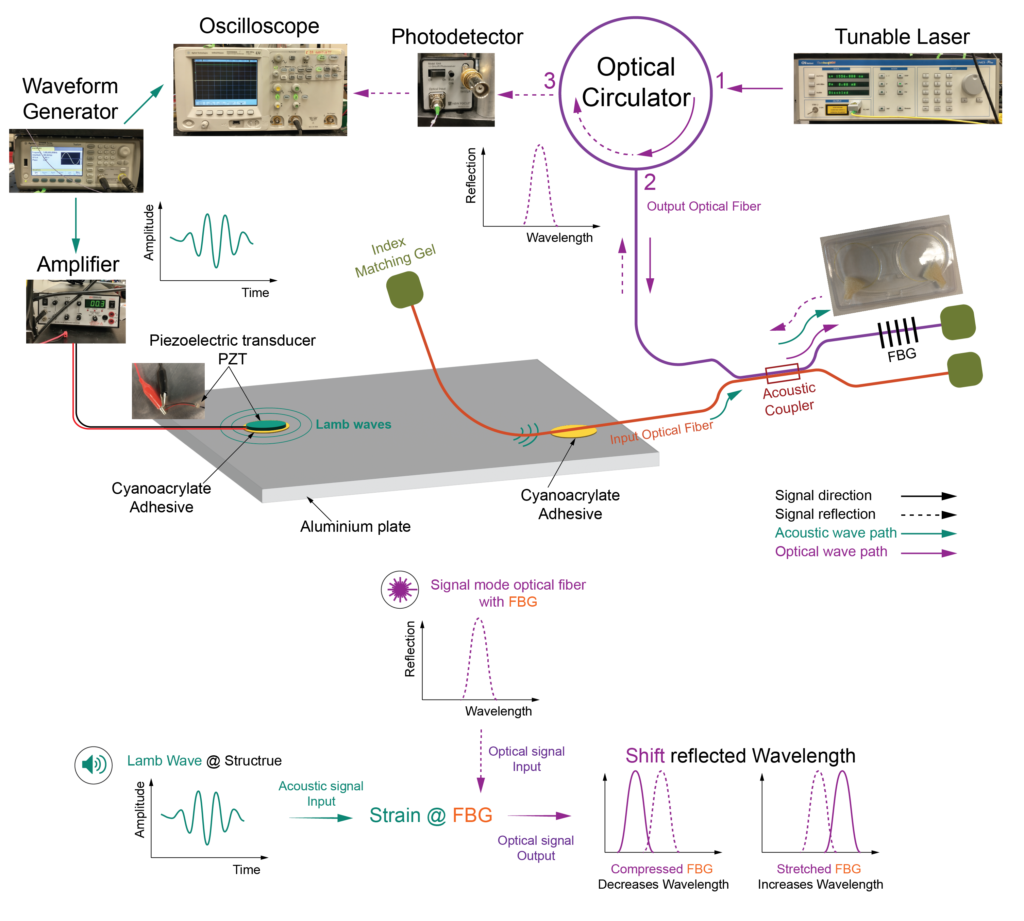
ONR #N00014-19-1-2053: Design of Acoustic Couplers for Sensing Applications.
PI: Dr. Kara Peters, North Carolina State University.

We achieved self-healing in a structural polymer that is 100 times faster and higher recovery in mode-I fracture toughness than the prior state-of-the-art (2021) two-part (epoxy/amine) system. This novel approach introduces a new paradigm for in situ self-healing of structural polymers for composites. Moreover, the embedded optical fibers have a dual function, serving as a self-sensing conduit to detect damage and relate chemical conversion to mechanical self-recovery.
Cure kinetics for formulated cationic photochemistry is established based on ex situ healing agent characterization via Raman spectroscopy and practical pathway for integrated in situ self-healing and sensing in laminated fiber reinforced polymer (FRP) composites.
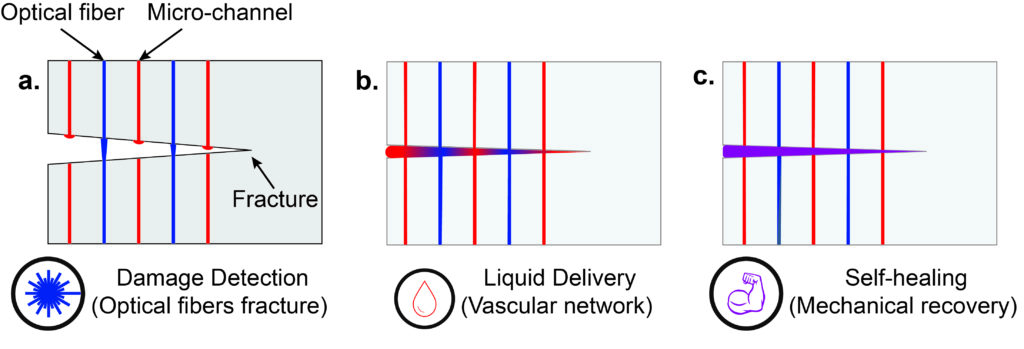
Self-healing structural polymer concept: Internal crack propagation and fracture of optical fibers (blue) releasing light; simultaneous rupture of microvascular networks (red) for delivery of liquid photo-chemistry; light-induced polymerization (violet) for in situ structural self-healing.

AFOSR #FA9550-18-1-0048: Integrated self-healing and self-sensing using optical waveguides in microvascular fiber-composites.
PI: Dr. Jason Patrick, North Carolina State University.

This 3D Bioprinter + Electrospinner hybrid system combines state-of-the-art (2017/2016) digital composite fabrication tools of 3D-bioprinting and electrospinning to target fabrication of hierarchical, 3D scaffolds for regeneration of bone, ligament, and the bone-ligament transition region.
The open-source, modular nature of our hybrid technology was achieved at a cost less than $10,000—which was nearly $100,000 less than any commercially-available 3D bioprinter with the same capabilities—and $15,000 less than the least expensive electrospinner.

PI: Dr. Christina Salas, The University of New Mexico’s Health Sciences Center.

Pelvic Ring Emergency Stabilizing System (PRESS): For unstable pelvic fractures that might require emergency surgery the binder should allow easy access to the groin and the abdominal area without any removal or reposition of the belt.
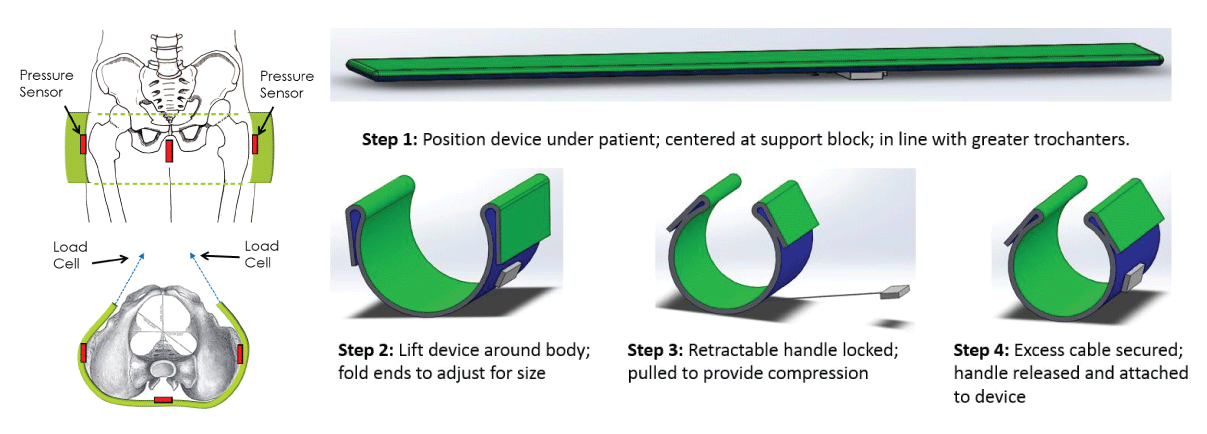
University of New Mexico Biodesign course, Innovation and Commercialization award, UNM Clinical and Translational Science Center and UNM School of Engineering (50,000 $).

The objective of this study is investigating structural features and mechanical properties of mammalian cells-silica replicas. These silica biocomposites are generated from mammalian cellular templates HeLa (CCL-2) and A549 (CCL-185) through translating cell architecture into inorganic materials (Silicification (S) and Calcination (C)).
Nano-mechanical characterization of cell-silica biocomposites was performed using nanoindentation and nanopositioner technique to investigate mechanical properties, while microstructural characterization will be performed to determine density and porosity of cell-silica biocomposite, in order to establish modulus-density scaling ratio.
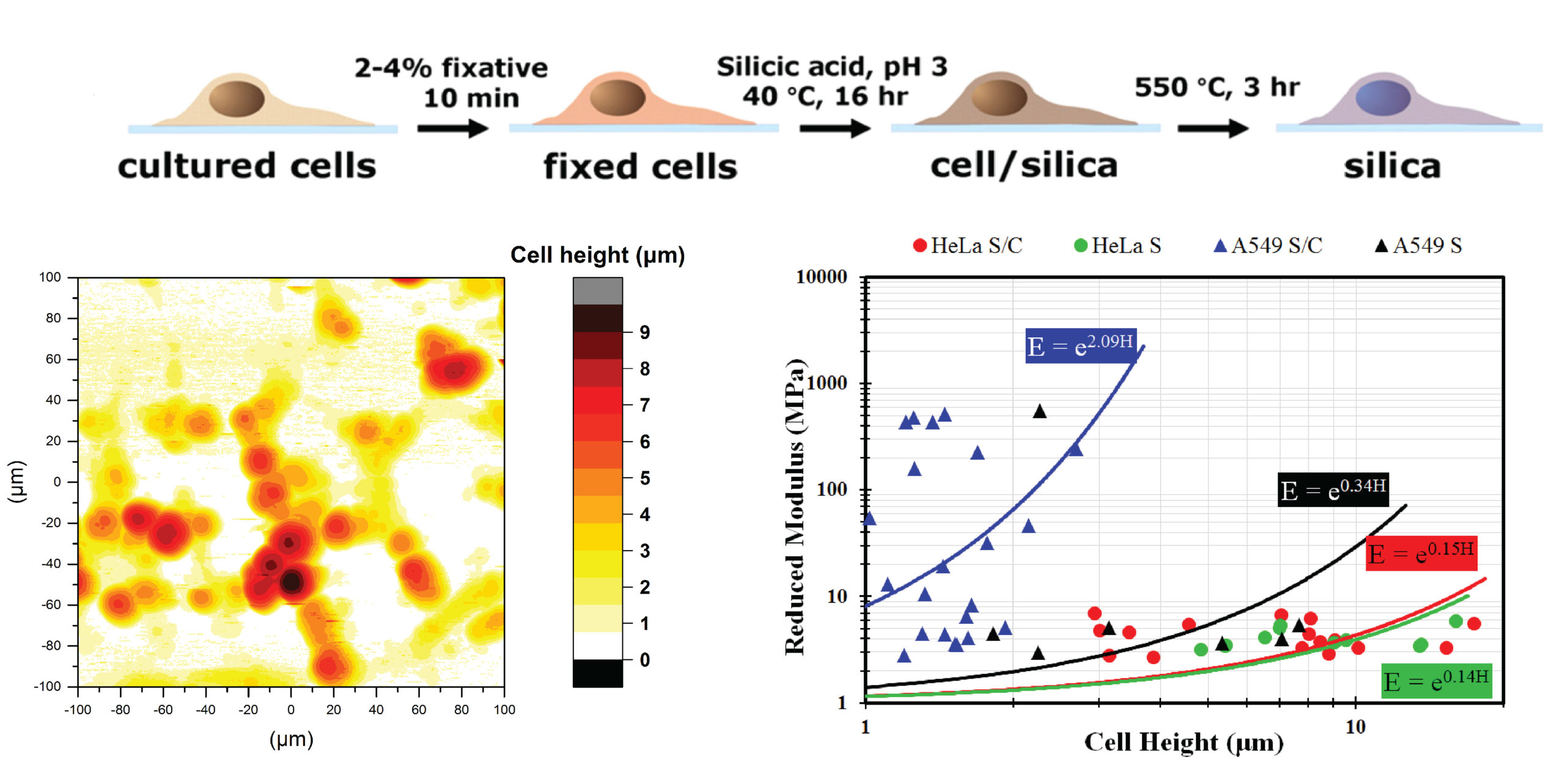
AFOSR #FA9550-14-1-0066: Biocompatible and biomimetic self-assembly of functional nanostructures.
PI: Dr. C. Jeffrey Brinker, University of New Mexico.

The objective of this study is to correlate elastic and viscoelastic mechanical properties of synthetic C-S-H synthesized at 0.7 and 1.5 CaO to SiO2 (C/S) ratios with physical characteristics such as density, and microstructural features such as porosity and silicate polymerization. Elastic and viscoelastic mechanical properties of compacted C-S-H specimens at both mixture ratios were extracted using nanoindentation. The modulus-density scaling relationship of both types of C-S-H was established and discussed.
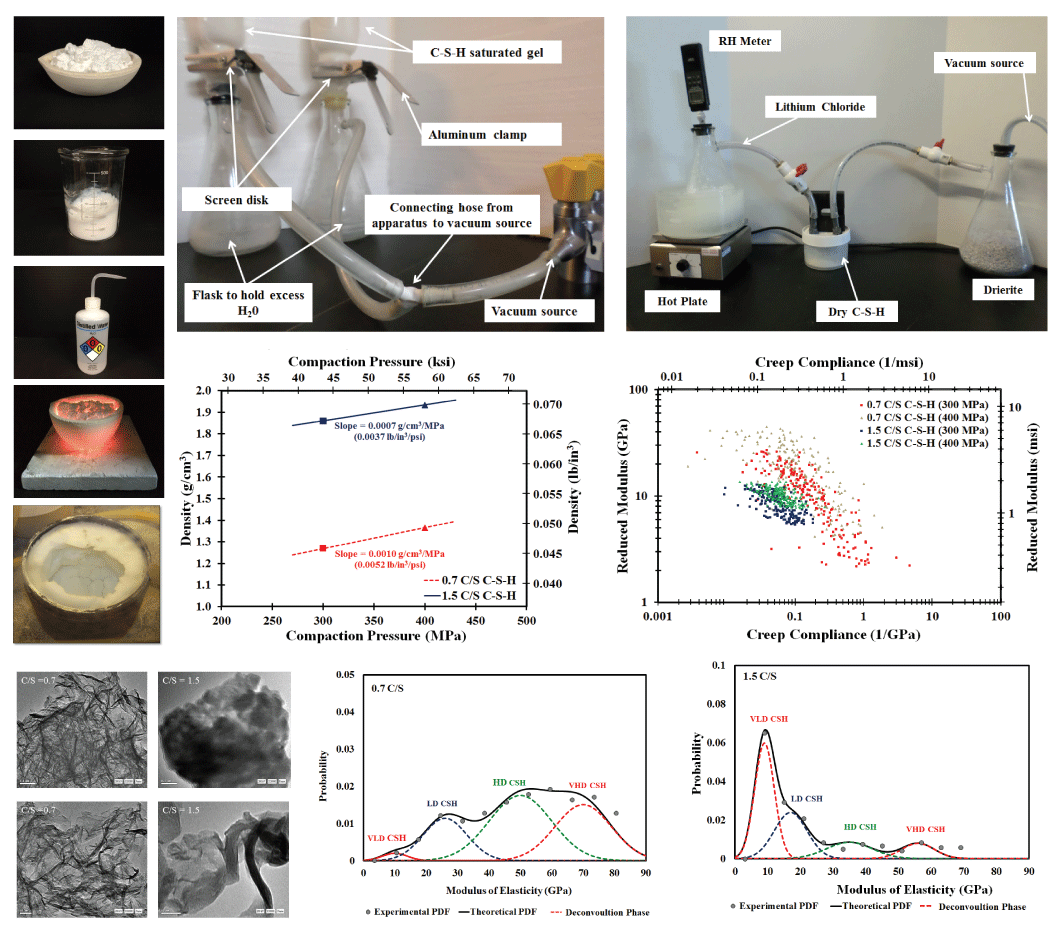
NSF #1131369: Synthesis and Multi-Scale Mechanical Characterization of CSH.
PI: Dr. Mahmoud Reda Taha, University of New Mexico.

Incorporating Nano-clay (NC) into epoxy matrix was proved to improve low-velocity impact responses, and limit damage evolution of Carbon fiber reinforced polymer (CFRP).
It is demonstrated that quantifying low velocity impact damage in CFRP using CT-scans might be possible for relatively low damage levels ( 1 – 20J) .
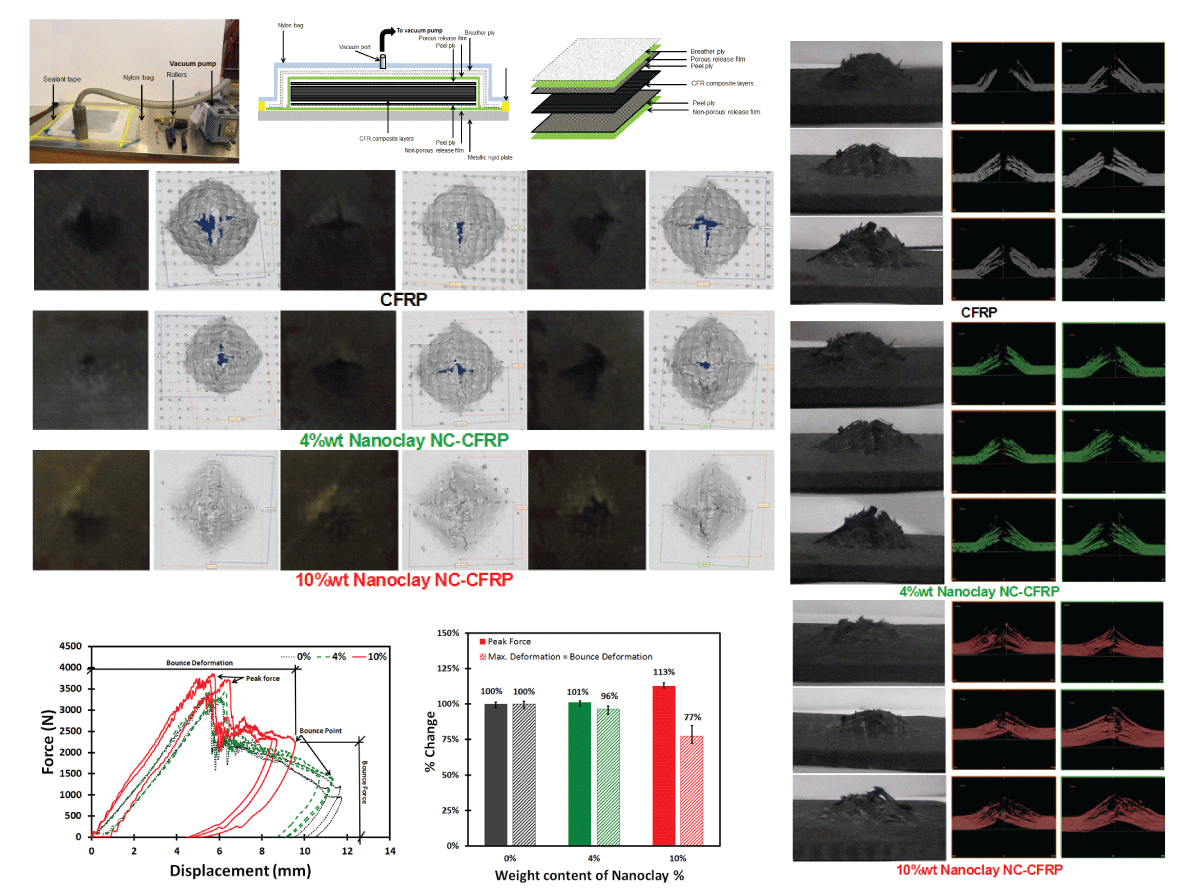
DTRA HDTRA1-08-1-0017 P00001: Next Generation composites using surface grown carbon nanotubes.
PI: Dr. Mahmoud Reda Taha, University of New Mexico.

Creep behavior of the epoxy-clay nanocomposite was examined using multi-scale testing protocols at the macro- and nano-scales. Macroscale creep was examined using double lap shear testing at the Carbon fiber reinforced polymer (CFRP)-steel interface while nanoscale creep was tested using nanoindentation.


The experimental observations showed that nanoscale creep of epoxy-clay nanocomposites cannot be up-scaled to the macroscale.
Microstructural characterization proved that nanoclay platelets reduced the chance of epoxy cross-linking by bonding to the free epoxide groups. However, intercalated nanoclay platelets can act as a uniform micro particulate reinforcement in the epoxy matrix and thus restrict the mobility of polymer chain and reduce creep compliance. Exfoliated nanoclay cannot produce this reinforcement effect due to their limited length scale and therefore increase epoxy compliance.

NSF- OISE #1103601: Nano-rubber toughened epoxy for energy absorbing composites.
PI: Dr. Mahmoud Reda Taha, University of New Mexico.